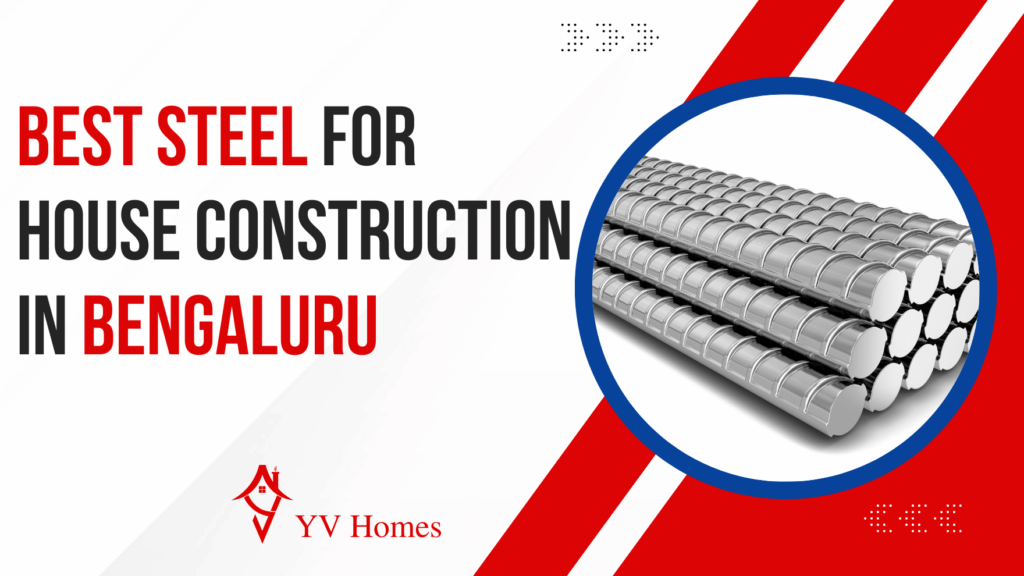
Why Steel Matters: Building a Strong and Durable House constrcution in bangalore
When it comes to house construction in bangalore, choosing the right steel for house constrcution is a critical decision that affects the durability, strength, and safety of your ho use. Steel provides excellent structural integrity, ensuring resistance to natural disasters, pests, and corrosion. Whether you’re building a small house or a multi-story home, the right steel selection will define the longevity of your investment.
✅ High Strength-to-Weight Ratio – Ensures stability and safety.
✅ Corrosion & Fire Resistance – Ideal for long-term durability.
✅ Eco-Friendly & Recyclable – A sustainable choice for modern homes.
Table of Contents
Why Steel is the Best Choice for House Construction?
Steel has become preferred in residential construction due to its high strength-to-weight ratio and numerous advantages over traditional materials like wood and concrete.
Here’s why it stands out:
1. Exceptional Durability
Steel structures withstand extreme weather conditions, including hurricanes, earthquakes, and heavy loads, ensuring long-lasting performance.
2. Cost-Effective in the Long Run
While the initial investment in steel may be higher, its minimal maintenance requirements and extended lifespan make it a cost-effective choice.
3. Sustainable and Eco-Friendly
Steel is 100% recyclable, reducing environmental impact and promoting sustainable construction practices.
4. Superior Design Flexibility
Architects and engineers favor steel for its ability to support innovative and complex designs without compromising structural integrity.
5. Fire and Pest Resistance
Unlike wood, steel is non-combustible and immune to termites and other pests, ensuring enhanced safety and longevity.
Types of Steel for House Construction
Understanding the different types of steel used in residential construction helps in making an informed decision. Here are the most commonly used variants:
1. TMT (Thermo-Mechanically Treated) Steel Bars
TMT bars are the most widely used reinforcement steel due to their:
High tensile strength
Superior bonding with concrete
Corrosion and earthquake resistance
Common Grades: Fe 500, Fe 550, and Fe 600
2. Mild Steel Bars
Mild steel bars have a smooth surface and lower tensile strength, making them suitable for:
Non-load-bearing structures
Small residential projects
3. Structural Steel
This type is used in building frameworks, including beams, columns, and roofs, and offers excellent load-bearing capacity. Popular structural steel sections include:
I-Beams (high load capacity)
Hollow Steel Sections (HSS) (lightweight structures)
Angle Bars (additional support in framing)
4. Galvanized Steel
Coated with zinc to prevent rusting, galvanized steel is ideal for moisture-prone or coastal areas. It is commonly used for:
Roofing sheets
Wall panels
Fencing materials
5. Stainless Steel
Though costly, stainless steel is widely used in architectural elements like railings, staircases, and decorative fixtures due to its corrosion resistance and modern aesthetic appeal.
How to Select the Best Steel for House Construction
To choose the most suitable steel for your house constrcution, consider the following factors:
1. Load Requirements
Different house components require different steel grades. For instance, TMT bars are ideal for reinforced concrete structures, while structural steel suits framing purposes.
2. Quality and Certifications
Ensure that the steel meets international and national quality standards such as BIS (Bureau of Indian Standards), ASTM, and ISO to guarantee superior performance.
3. Corrosion Resistance
For humid or coastal regions, opt for corrosion-resistant options like galvanized or stainless steel to enhance longevity.
4. Comparing Brands and Pricing
Leading steel manufacturers such as TATA Steel, JSW Steel, and SAIL provide high-quality products. While comparing prices, prioritize durability and quality over cost alone.
5. Consult a Structural Engineer
A professional Structural engineer can assess your construction needs and recommend the appropriate type and grade of steel for optimal structural integrity.
Best Brands for High-Quality House Construction Steel
If you are looking for reliable steel brands, consider these top options:
TATA Tiscon – Renowned for premium TMT bars and structural steel.
JSW Steel – Offers corrosion-resistant and earthquake-proof steel solutions.
SAIL (Steel Authority of India Limited) – A leading supplier of high-grade steel in India.
Essar Steel – Provides top-tier steel for residential and commercial projects.
VIZAG Steel – Delivers steel that meets stringent national and international quality standards.
Conclusion
Selecting the right steel is fundamental to constructing a strong, durable, and safe choose. Depending on your structural requirements, TMT bars, structural steel, and galvanized steel are among the best choices. Always purchase from reputable brands, verify certifications, and seek expert guidance to make informed decisions.
Investing in high-quality steel ensures a robust foundation, ultimately securing your home for generations to come. If you’re planning a construction project, carefully assess the factors outlined in this guide to choose the best steel for your needs and budget.
Frequently Asked Questions
About Steel for House Construction in Bangalore
Steel is used in home construction due to its strength, durability, and resistance to environmental factors such as termites, fire, and moisture. It also allows for flexible designs and faster construction times compared to traditional materials.
Common types of steel used in home construction include:
Mild Steel: Used for structural components like beams and columns.
Reinforced Steel (Rebar): Provides strength to concrete structures.
Galvanized Steel: Used for roofing, framing, and fencing due to its corrosion resistance.
Stainless Steel: Used in areas prone to moisture for rust resistance.
SteelSteel is stronger, more durable, and resistant to termites, fire, and rot compared to wood. However, it can be more expensive and requires skilled labor for installation.
Yes, steel is recyclable and often made from recycled materials. It reduces the need for deforestation and produces less waste during construction.
Higher initial cost compared to wood.
Requires skilled labor for installation.
Can be prone to corrosion if not properly treated.
Conducts heat, requiring proper insulation to maintain energy efficiency.
o prevent rusting, steel should be coated with protective layers such as galvanization (zinc coating), paint, or anti-corrosion treatments. Regular maintenance can also extend its lifespan.
Steel framing is lighter, more flexible, and faster to install than concrete. However, concrete offers better thermal mass and can be more affordable in some cases. The choice depends on budget, location, and specific project needs.
Yes, steel is a popular roofing material due to its durability, weather resistance, and low maintenance. It is commonly used in the form of corrugated sheets, metal tiles, or standing seam panels.
A well-maintained steel-framed house can last 50 to 100 years or more, depending on environmental conditions and protective treatments.
Since steel is fire-resistant and more durable, some insurance providers offer lower premiums for steel-framed homes. However, this depends on local regulations and insurance policies.
Yes, steel is an excellent choice for earthquake-prone areas due to its flexibility and high strength-to-weight ratio, which helps absorb and dissipate seismic forces.
Teel framing can have higher upfront costs due to material and labor requirements, but it often reduces long-term maintenance and repair costs.
Yes, steel is used for staircases, railings, partitions, and even decorative elements due to its modern aesthetic and durability.
Maintenance includes periodic inspections for rust, applying protective coatings, checking for structural integrity, and ensuring proper insulation against condensation.
Steel can be purchased from local suppliers, hardware stores, and specialized steel fabricators. It is important to ensure high-quality standards and proper certifications when buying steel.





